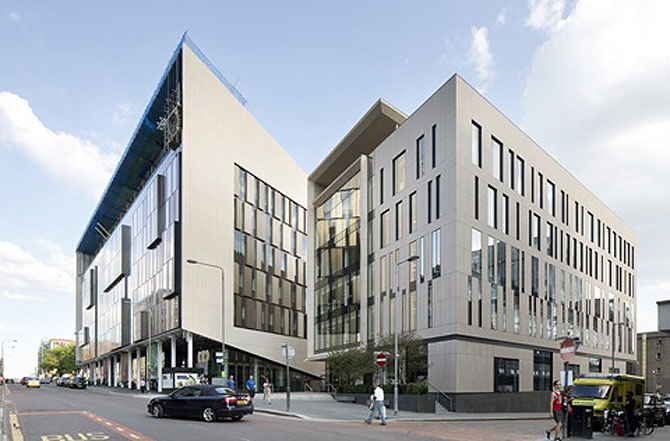|
Connected Places Catapult
The Connected Places Catapult is the UK government's innovation agency for cities, transport and place leadership. It is one of several Catapult centres. History The organisation was formerly known as the Future Cities Catapult and also the Transport Systems Catapult, which were joined together on 1 April 2019. It works with Innovate UK, in Swindon (Wiltshire). A Deep Academic Alliance agreement was signed with UK universities in July 2018. Future Cities Catapult The Future Cities Catapult opened in London in 2013, to develop smart cities. Its first chairman was Sir David King, a professor of physical chemistry who was previously the government's Chief Scientific Adviser. Transport Systems Catapult The Transport Systems Catapult opened in June 2014 in Milton Keynes, Buckinghamshire, directly west of Witan Gate House. The TSC worked with Wayra UK. Sites A site at the University of Leeds (at a new innovation centre that opened in 2018) opened in May 2019. A site at the Univer ... [...More Info...] [...Related Items...] OR: [Wikipedia] [Google] [Baidu] |
Catapult Centres
Catapult centres are organisations set up from 2011 onwards by Innovate UK in the United Kingdom to promote research and development through business-led collaboration between scientists and engineers to exploit market opportunities. They receive grants from public funds but are also expected to seek commercial funding. History In 2010, the Department for Business, Innovation and Skills commissioned a report on technical innovation from Hermann Hauser, an entrepreneur who had been active in information technology since 1978. The report recommended the establishment of a number of Technology and Innovation Centres. Each centre received "core" funding of £10 million per year for five years via the Technology Strategy Board (which since 2014 has used the name Innovate UK). Since 2018, Innovate UK has been a council of United Kingdom Research and Innovation, a non-departmental public body. It was intended that the long-term split would be one-third core funding, one-third comm ... [...More Info...] [...Related Items...] OR: [Wikipedia] [Google] [Baidu] |
Automated Driving System
Vehicular automation involves the use of mechatronics, artificial intelligence, and multi-agent systems to assist the operator of a vehicle (car, aircraft, watercraft, or otherwise).Hu, J.; Bhowmick, P.; Lanzon, A.,Group Coordinated Control of Networked Mobile Robots with Applications to Object Transportation IEEE Transactions on Vehicular Technology, 2021.Hu, J.; Bhowmick, P.; Jang, I.; Arvin, F.; Lanzon, A.,A Decentralized Cluster Formation Containment Framework for Multirobot Systems IEEE Transactions on Robotics, 2021. These features and the vehicles employing them may be labeled as ''intelligent'' or ''smart''. A vehicle using automation for difficult tasks, especially navigation, to ease but not entirely replace human input, may be referred to as ''semi-autonomous'', whereas a vehicle relying solely on automation is called robotics, robotic or autonomous robot, autonomous. Both of these types are instantiated in today's various self-driving cars, unmanned surface vehicle ... [...More Info...] [...Related Items...] OR: [Wikipedia] [Google] [Baidu] |
Transport Organisations Based In The United Kingdom
Transport (in British English), or transportation (in American English), is the intentional movement of humans, animals, and goods from one location to another. Modes of transport include air, land (rail and road), water, cable, pipeline, and space. The field can be divided into infrastructure, vehicles, and operations. Transport enables human trade, which is essential for the development of civilizations. Transport infrastructure consists of both fixed installations, including roads, railways, airways, waterways, canals, and pipelines, and terminals such as airports, railway stations, bus stations, warehouses, trucking terminals, refueling depots (including fueling docks and fuel stations), and seaports. Terminals may be used both for interchange of passengers and cargo and for maintenance. Means of transport are any of the different kinds of transport facilities used to carry people or cargo. They may include vehicles, riding animals, and pack animals. Vehicles may incl ... [...More Info...] [...Related Items...] OR: [Wikipedia] [Google] [Baidu] |
Transport In The London Borough Of Islington
Transport (in British English), or transportation (in American English), is the intentional movement of humans, animals, and goods from one location to another. Modes of transport include air, land (rail and road), water, cable, pipeline, and space. The field can be divided into infrastructure, vehicles, and operations. Transport enables human trade, which is essential for the development of civilizations. Transport infrastructure consists of both fixed installations, including roads, railways, airways, waterways, canals, and pipelines, and terminals such as airports, railway stations, bus stations, warehouses, trucking terminals, refueling depots (including fueling docks and fuel stations), and seaports. Terminals may be used both for interchange of passengers and cargo and for maintenance. Means of transport are any of the different kinds of transport facilities used to carry people or cargo. They may include vehicles, riding animals, and pack animals. Vehicles may in ... [...More Info...] [...Related Items...] OR: [Wikipedia] [Google] [Baidu] |
Science And Technology In West Yorkshire
Science is a systematic endeavor that builds and organizes knowledge in the form of testable explanations and predictions about the universe. Science may be as old as the human species, and some of the earliest archeological evidence for scientific reasoning is tens of thousands of years old. The earliest written records in the history of science come from Ancient Egypt and Mesopotamia in around 3000 to 1200 BCE. Their contributions to mathematics, astronomy, and medicine entered and shaped Greek natural philosophy of classical antiquity, whereby formal attempts were made to provide explanations of events in the physical world based on natural causes. After the fall of the Western Roman Empire, knowledge of Greek conceptions of the world deteriorated in Western Europe during the early centuries (400 to 1000 CE) of the Middle Ages, but was preserved in the Muslim world during the Islamic Golden Age and later by the efforts of Byzantine Greek scholars who brought Greek ma ... [...More Info...] [...Related Items...] OR: [Wikipedia] [Google] [Baidu] |




